Staunton holds ceremony for Green Street redesignation
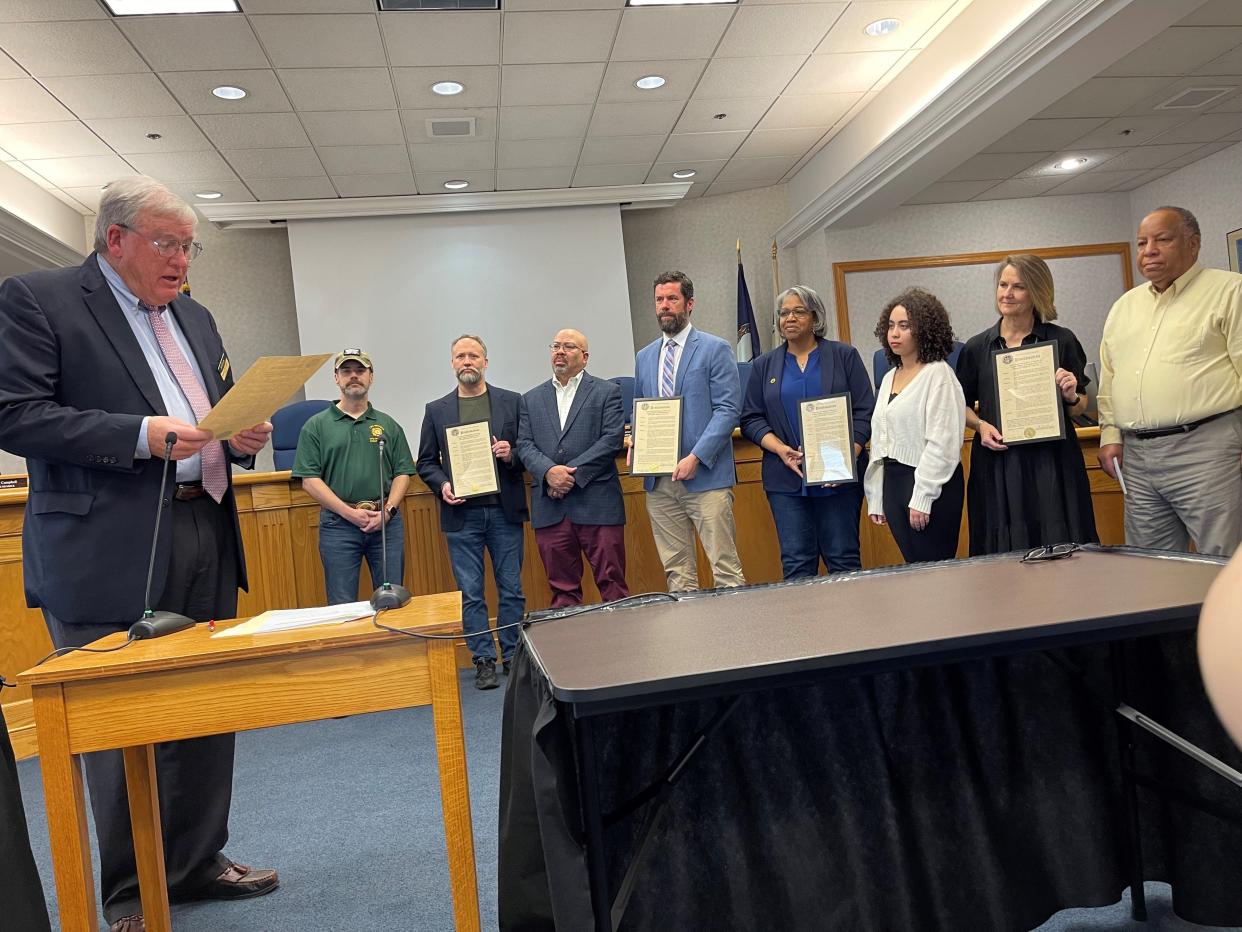
- Oops!Something went wrong.Please try again later.
Buffalo Soldiers, Tuskegee Airmen, climbing a tree under military fire, invading Cuba, blowing up a Nazi munitions cache, and helping the British supply Yuogslav communist rebels.
These are some of the actions of William Green Sr. and William Green Jr. Both served in the United States Armed Forces, a father-and-son pair of highly decorated veterans whose service ranges from the Spanish American War to the Korean War. The two were also African American Staunton locals, with Green Sr. moving to Staunton after his service and Green Jr. born and raised in the city.
Staunton City Council redesignated Green Street to honor and commemorate their military service with a ceremony and proclamation on Jan. 26.
Green Street redesignated
Col. Melissa Patrick, Thomas Fields VFW Post 7814, combed through public records and newspaper reporting to create a history of the Green’s military careers. She presented her findings to a packed City Council chambers.
"It is a privilege on my part to talk about why we are recognizing these two African American war heroes associated with Staunton," said Patrick.
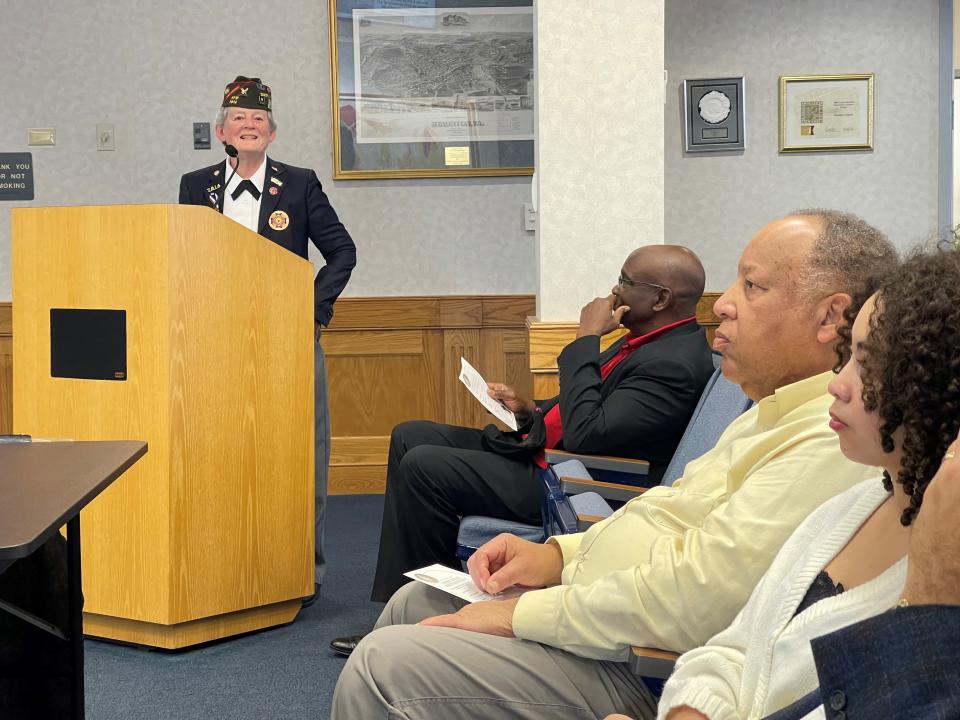
After hearing the story, Staunton Mayor Stephen Claffey presented the Green family members present with copies of the redesignation proclamation. Reginald Green, the grandson of Green Sr. and son of Green Jr., told The News Leader Patrick was able to dig deeper into their service than he had been able to.
“It’s not something I want to be too boastful or prideful of because I didn’t do it,” said Reginald Green. “They did those great things and I’m happy to know about them. My grandfather died shortly after we got back from Japan, when I was only a couple of years old. My father didn’t talk in that much detail about the specifics of his combat, so it’s a humbling feeling to hear about that from him and Colonel Patrick.”
The following is a retelling of Patrick's presentation for The News Leader readers.
Green Sr. in Cuba, Spanish American War
In 1898, the Spanish American War was raging. This fight would ultimately result in a temporary, United States-controlled government in Cuba and Puerto Rico permanently falling into U.S. control. William Washington Green Sr. signed up, joining the 24th Infantry Regiment. This was "one of the original" Buffalo Solider regiments, all African American soldiers that served under white officers.
After fighting in Cuba, Green was sent to the Philippines. According to the U.S. Department of State archives, The Philippine-American War began after the Spanish lost the Spanish American War.
"Spain ceded its longstanding colony of the Philippines to the United States in the Treaty of Paris," reads the archive. "On February 4, 1899, just two days before the U.S. Senate ratified the treaty, fighting broke out between American forces and Filipino nationalists led by Emilio Aguinaldo who sought independence rather than a change in colonial rulers."
After this, Green was part of the force deployed into Mexico to capture Pancho Villa, a Mexican general who successfully led a rebellion against the Mexican government.
Green was promoted, attending the first officer training school for African American soldiers.
"When World War I started, initially the war department did not plan on commissioning African Americans to fight in the war," Patrick explained. "Under political pressure, they finally agreed to set up an officer training school, just one, to train African Americans to get commissions. That was at Fort Des Moines, Iowa."
Now Master Sgt. William Green, Green was one of 250 senior non-commissioned officers from Buffalo Soldier regiments selected for the Des Moines school. He was commissioned as a captain and given command of a company in the 365 Infantry Regiment of the 92nd Division.
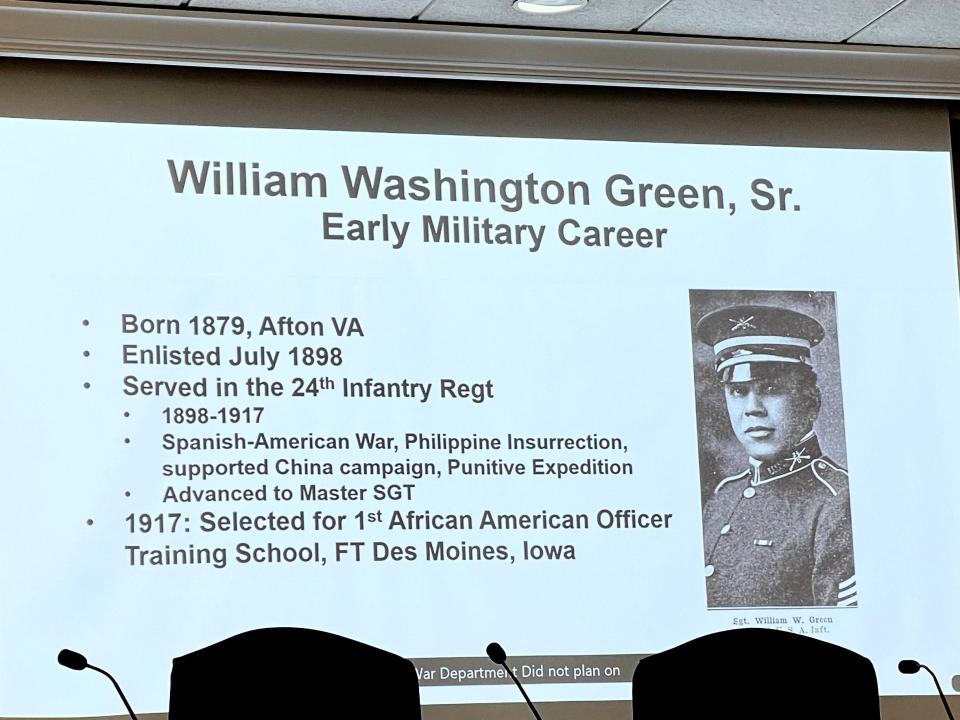
Green Sr. in France, World War I
The company arrived in France in July 1918, then were allowed into combat in October, fighting in the Meuse–Argonne campaign.
"On the 10th of October 1918, Captain Green, with utter disregard for his own personal danger, went out under enemy machine gun and shell fire, rescued three wounded men of his company who were lying in an in an exposed position, administered first aid, and carried them, one at a time, to a place of comparative safety," Patrick said. "In other words, he went out three times to rescue his men."
On Nov. 10, Green led his command through "wire and heavy enemy fire" on a mission. Green climbed a tree "in order to see over the crest of the hill behind which the enemy was advancing." Now completely exposed, bullets ripping branches off the tree, Green coordinated his men and "was able to repulse successfully three enemy counter attacks."
Writing on this experience to the regimental commander, Green wrote the unit "advanced more than eight miles under the most terrific bombardment with high explosives, gas and machine gunfire I ever experienced."
After the war, Green remained in the army, working as an ROTC instructor at North Carolina A&T. His son, William W. Green Jr., was born in Greensboro, North Carolina, and the family moved to Staunton, his wife Virginia's hometown.
Green Jr. in Italy, World War II
The family lived together in Staunton on Park Boulevard. Green Jr. graduated from the segregated Booker T. Washington High School in 1939, then left to attend North Carolina A&T. He did not graduate however, leaving to join the army before his expected graduation date in 1942. He initially enlisted as a private but was trained as a pilot, then assigned to the 302nd fighter squadron. Now a Tuskegee Airman, he fought in World War II, stationed in Italy.
Green Jr. was awarded the Distinguished Flying Cross and the Air Medal for his service, but the United States government was not the only government to award him.
Green Jr. and his wingman were returning to Italy from an escort mission over Hungary when they saw fighters from Yugoslavia attacking a large barn.
"We swooped down and made three passes at a large barn," Green told a newspaper Louisville, Kentucky. "On the third try, it exploded, and our plane was damaged by flying debris."
Now unable to fly, five local people took him to safety. He had just helped the Yugoslavic Partisans destroy a Nazi munitions cache. His wingman was not so lucky — he was captured by the Germans.
The Partisans were led by Josip Broz Tito. The county split from Austria-Hungary after World War I, and was run by a monarchy. When the Nazis invaded Yugoslavia in 1941, the communist party members, organized by Tito, turned into resistance fighters, ultimately gaining the support of the U.S. and its Allies. After the war, one in ten Yugoslavs were gone and Tito was named "Marshal of Yugoslavia" in the provisional government. Tito led the country as either prime minister or president until his death in the 1980s.
Green Jr. spoke with several Partisans and volunteered to help a British supply mission drop supplies to Partisan fighters. These two acts, the destruction of the barn and the supply drop, led the Partisans to award Green the Yugoslav Order of the Partisan Star, the only American to ever receive the award.
Ultimately, Green flew 123 combat missions in World War II, and several combat missions in the Korean War, staying with the Army until he retired in July 1950.
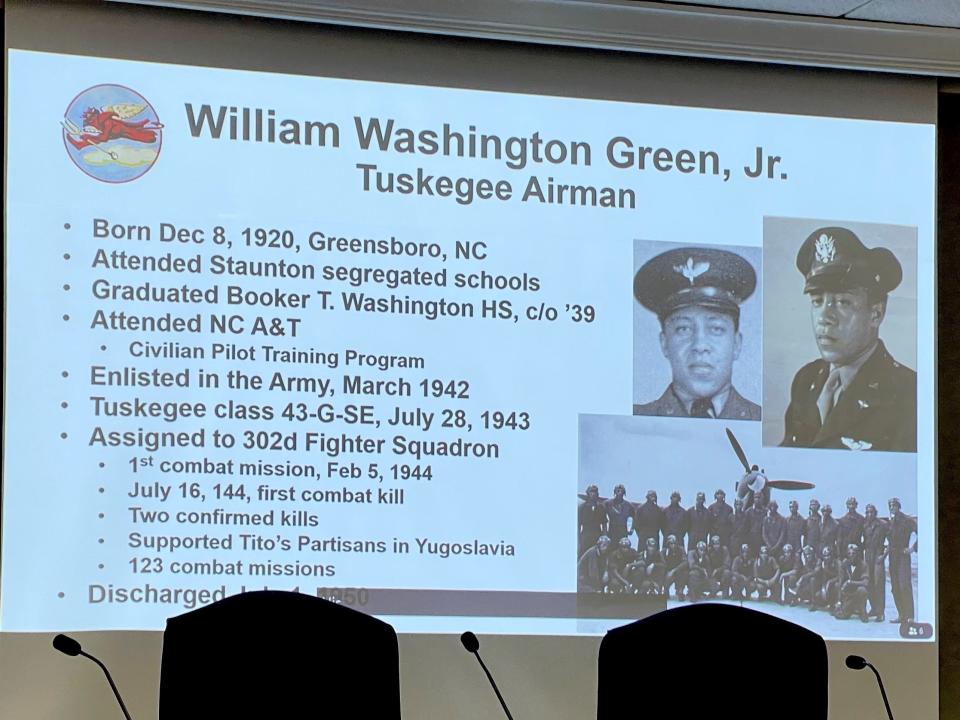
The Green family in Staunton
Franklin Green Jr., grandson of Green Sr. and nephew of Green Jr., told The News Leader he has not been to Staunton for decades.
"It’s different, very different," Franklin said. "We’re staying out in the Fairview Inn. That was cornfields — there was nothing there last time I was here.”
William Green Sr. passed when Reginald Green was only a few years old, but he told The News Leader other family members shared that he was "modest" about his service. According to Franklin, Green Jr. did not speak on his service openly often, if at all.
“We never really talked about what he did," Franklin Green said. "It wasn’t until I was older, maybe high school, that I realized how important he actually was, the awards he got, the heroism he showed. To me, he was just uncle William.”
When asked what his father, Green Jr., was like at home, Reginald Green said, “He was very gregarious. As a kid, we were in Ohio because that’s where the Tuskegee Airman were last located before they disbanded. I remember quite well, other people that he served with, other Tuskegee Airman, would stop over at the house. They would have a lot of laughs, kidding each other. That’s one thing that gave me an understanding, as a six-, seven- or eight-year-old kid, of the camaraderie, the brotherhood that pulled them together.”
After the redesignation, the Greens hope to continue to keep the memory of their family's service alive.
“We’re trying to get our grandfather’s award and bring it to a Medal of Honor," Franklin Green said. "We’re convinced that, if he had been white, he would have gotten a medal of honor. That’s the next thing we’re going for.”
Patrick was interviewed by Staunton’s communications team, where she highlighted that the Greens served “at a time when they didn’t have full civil rights.”
"I think it's an inspiring story,” Patrick said. “As we think about the nation's history, both the good and the bad,” the American people can “look at fellow Americans who were loyal and proud of their country and served their country, even though they had many reasons not to.”
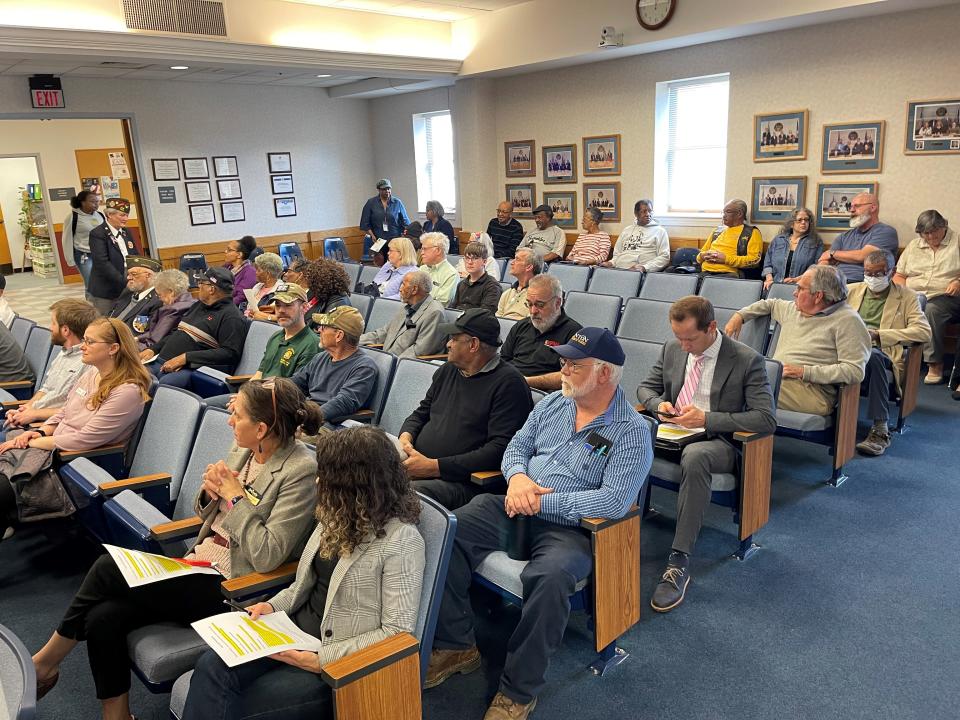
This article originally appeared on Staunton News Leader: Staunton holds ceremony for Green Street redesignation

